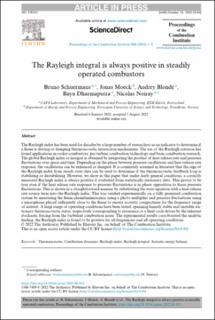| dc.contributor.author | Schuermans, Bruno | |
| dc.contributor.author | Moeck, Jonas | |
| dc.contributor.author | Blonde, Audrey | |
| dc.contributor.author | Dharmaputra, Bayu | |
| dc.contributor.author | Noiray, Nicolas | |
| dc.date.accessioned | 2023-02-22T09:57:44Z | |
| dc.date.available | 2023-02-22T09:57:44Z | |
| dc.date.created | 2022-10-17T13:09:52Z | |
| dc.date.issued | 2022 | |
| dc.identifier.citation | Proceedings of the Combustion Institute. 2022, . | en_US |
| dc.identifier.issn | 1540-7489 | |
| dc.identifier.uri | https://hdl.handle.net/11250/3053108 | |
| dc.description.abstract | The Rayleigh index has been used for decades by a large number of researchers as an indicator to determine if a flame is driving or damping thermoacoustic interaction mechanisms. The use of the Rayleigh criterion has found applications in rocket combustors, gas turbine combustion technology and basic combustion research. The global Rayleigh index or integral is obtained by integrating the product of heat release rate and pressure fluctuations over space and time. Depending on the phase between pressure oscillations and heat release rate response, the oscillations can be enhanced or damped. It is commonly assumed in literature that the sign of the Rayleigh index from steady state data can be used to determine if the thermoacoustic feedback loop is stabilizing or destabilizing. However, we show in this paper that under fairly general conditions, a correctly measured Rayleigh index is always positive if evaluated from statistically stationary data. This proves to be true even if the heat release rate response to pressure fluctuations is in phase opposition to those pressure fluctuations. This is shown in a straightforward manner by substituting the wave equation with a heat release rate source term into the Rayleigh index. This was verified experimentally on a fully premixed combustion system by measuring the flame chemiluminescence using a photo multiplier and pressure fluctuations using a microphone placed sufficiently close to the flame to ensure acoustic compactness for the frequency range of interest. A large range of operating conditions have been tested, spanning linearly stable and unstable stationary thermoacoustic states, respectively corresponding to resonance or a limit cycle driven by the inherent stochastic forcing from the turbulent combustion noise. The experimental results corroborated the analytic finding: the Rayleigh index is found to be positive for all frequencies and all operating conditions. | en_US |
| dc.language.iso | eng | en_US |
| dc.publisher | Elsevier | en_US |
| dc.rights | Navngivelse 4.0 Internasjonal | * |
| dc.rights.uri | http://creativecommons.org/licenses/by/4.0/deed.no | * |
| dc.title | The Rayleigh integral is always positive in steadily operated combustors | en_US |
| dc.title.alternative | The Rayleigh integral is always positive in steadily operated combustors | en_US |
| dc.type | Peer reviewed | en_US |
| dc.type | Journal article | en_US |
| dc.description.version | publishedVersion | en_US |
| dc.source.pagenumber | 9 | en_US |
| dc.source.journal | Proceedings of the Combustion Institute | en_US |
| dc.identifier.doi | 10.1016/j.proci.2022.08.035 | |
| dc.identifier.cristin | 2062002 | |
| cristin.ispublished | true | |
| cristin.fulltext | original | |
| cristin.qualitycode | 1 | |

